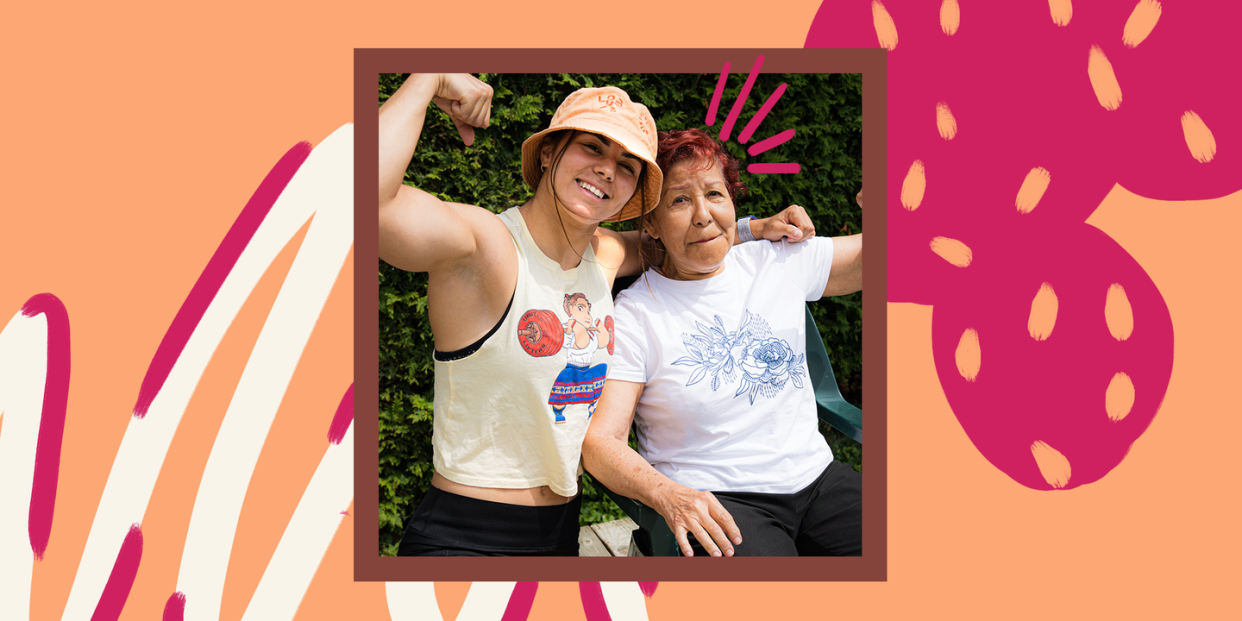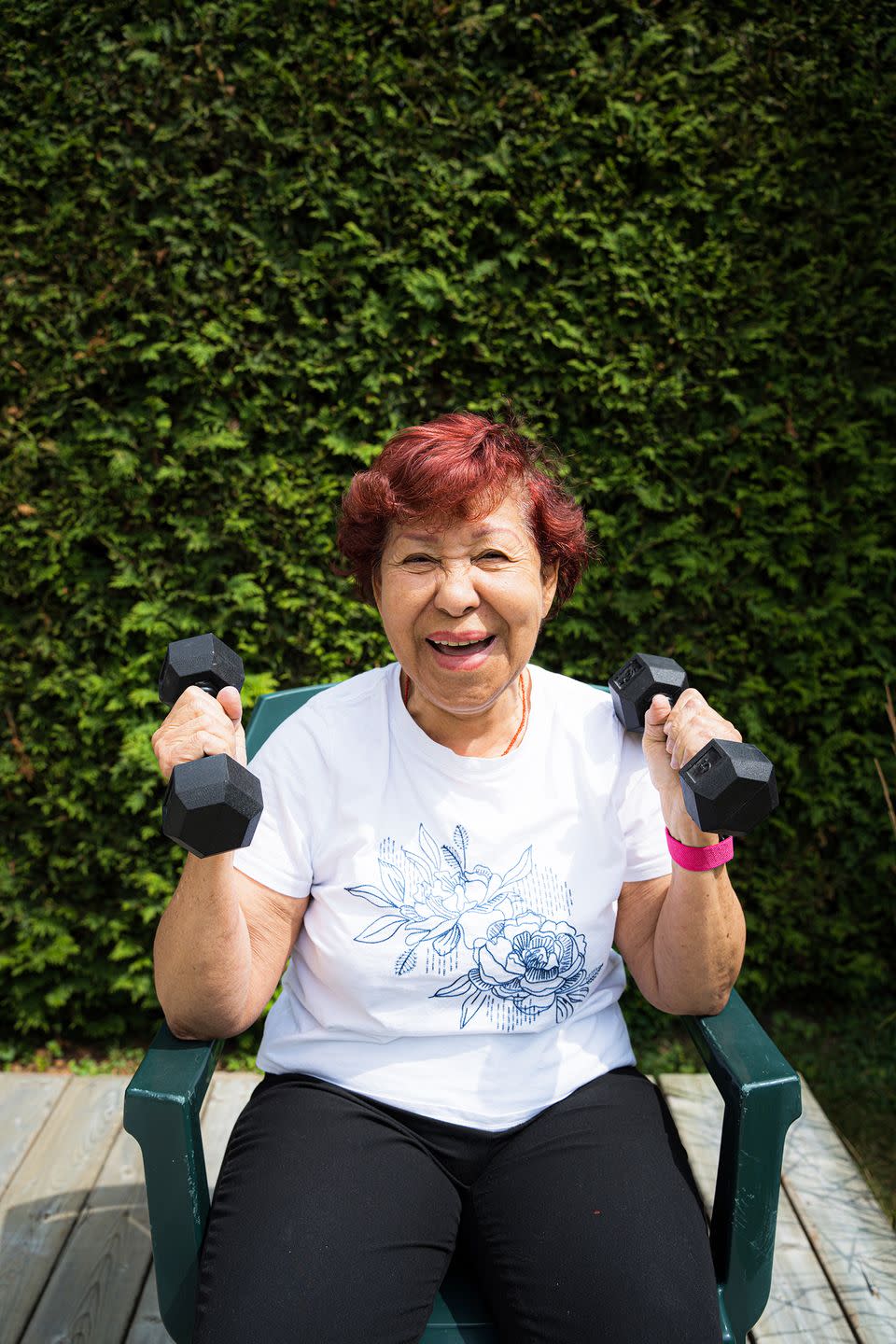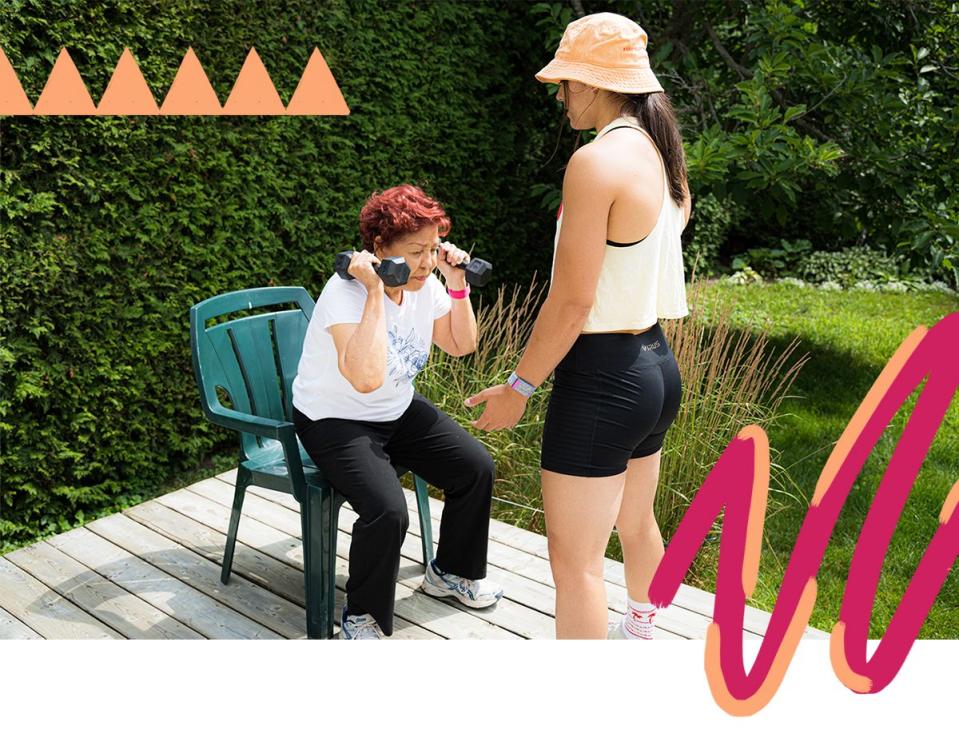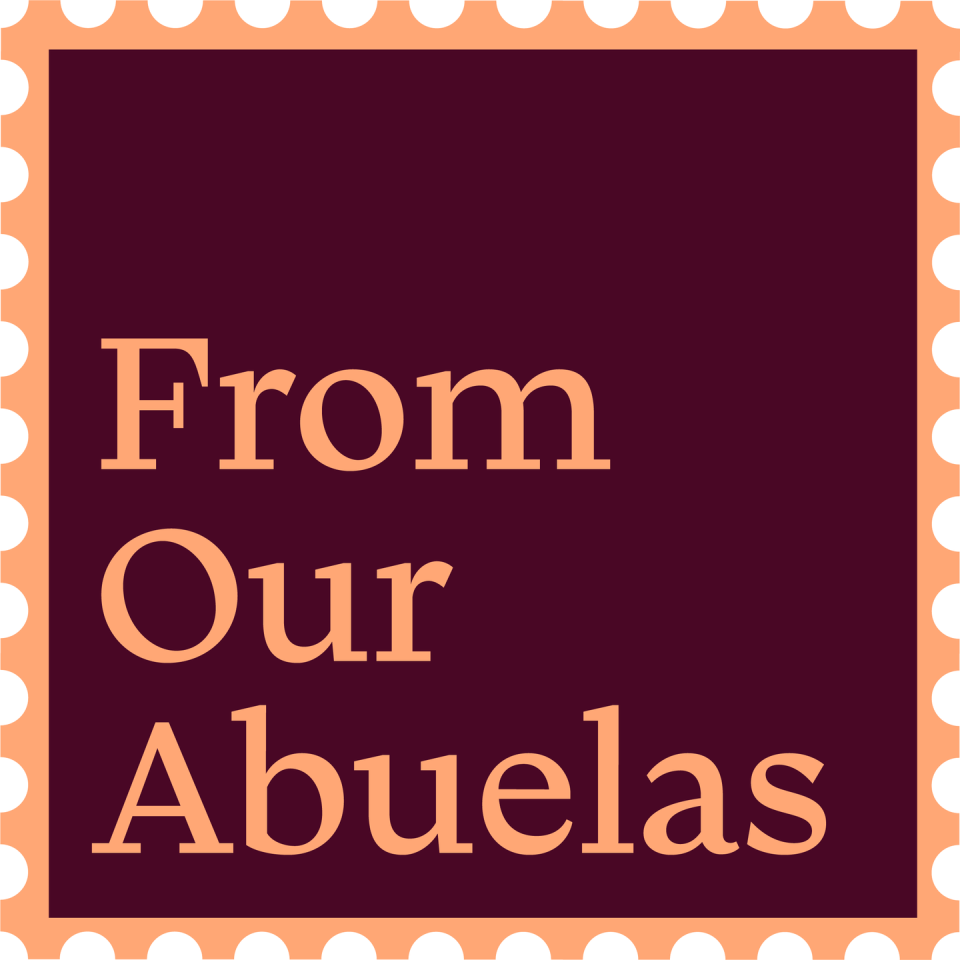'How I Turned My 85-Year-Old Abuela Into My Workout Partner’

When Natalie Allport, 28, a Venezuelan-Canadian pro-CrossFit athlete living in Ottawa, Canada, injured her shoulder in a motorbike accident in 2019, she was forced to pause CrossFit competitions and slow down her fitness routine (the recovery process took over two years). Instead of taking that time off from training altogether, she decided to start working out with her abuela Juanita Arteaga, 85, every day, either in person or virtually.
Arteaga had been active in various senior groups up until the pandemic, but when everything shut down, her health declined as she struggled to keep moving. So for Allport, creating a fitness routine for her abuela, and coaching her through it, was the perfect challenge, as well as a way to stay active herself (albeit in a much more recovery-focused fashion). Fitness transformed the pair’s bond and brought them closer.
Arteaga has come a long way from her granddaughter teaching her how to squat. She is committed to showing up even when she’s tired or having a difficult day. This commitment to her fitness inspired Allport through her injury recovery in a powerful way—one that her younger teammates probably couldn’t have given her. “I mostly trained alone during the height of the pandemic. Having that daily FaceTime workout with Abuela definitely kept me motivated,” says Allport.
Even though Allport has recently been cleared for full-sport activity and is back to working out with teammates, she still makes time to train with her abuela every day too. “I train her for her health, to spend time together, and to maintain her routine,” says Allport. Videos of the duo working out together that Allport has posted on Instagram have been a huge hit, inspiring people to get moving with their grandparents.
Women’s Health spoke with Allport about how working out with unexpected partners, including your elders, can be one of the best ways to boost your health (and theirs!). The lesson? The best workout buddy is simply one who shows up and makes you happy to be there.

WOMEN’S HEALTH: Tell us about how you got inspired to start working out with your abuela.
NATALIE ALLPORT: She was doing senior classes at the gym. She’s super competitive and would race people in the warm-up. She did swimming lessons and ran with a Latin seniors group. But when the pandemic happened, everything was canceled and she was isolated from her community. I thought, why don’t we do a class for an hour a day since she wasn’t going to her club? In a typical week, I usually see her once in person, and the rest of the days virtually.
WH: How did you develop a training plan for her?
NA: She memorizes the typical exercises we do. With new exercises, she’d often forget them, then her heart rate would come down as she tried to learn it, and we’d lose the purpose of the exercise. So we do a lot of the same routines. She’ll do 30 squats, 10 shuttle runs, 20 squats, 10 shuttle runs, 10 squats, 10 shuttle runs, and a water break. Then, repeating band pull-aparts so I don’t have to re-explain the exercises and her heart rate stays elevated throughout.
WH: How has exercising helped your abuela stay independent?
NA: We focus on squatting with a chair—sitting down and standing back up—so her legs are strong to go up and down the stairs. We do fast-paced walking to keep her heart rate up. My dad made homemade weights for light deadlifts so she can always pick things up. We do banded pull-aparts to help with posture because she has back pain. She was a massage therapist in Venezuela and always hunched over. Now she does crafts—sewing and drawing—hunched over a table. I want to improve her posture.
WH: What are some of her favorite workouts?
NA: Any sport! I usually incorporate some type of sport and play into what we’re doing because it’s more enjoyable. She likes squats. We do those most often. She’s always trying to race. I’ll do squats with a weight while she’s squatting to a chair. She sees me moving fast on my squats and starts racing me and I remind her to move slowly and do the full rep. She also likes to ride the stationary bike at my parent’s house if I’m not able to give her a class.

WH: How did your abuela inspire you while you were recovering from your shoulder injury?
NA: Doing shoulder rehab exercises is boring. While my abuela did her workout, I did my shoulder exercises. It helped me stay accountable. Seeing her move every single day inspired me. She never complains. That helped me manage the highs and lows of the injury process. I have so much admiration for her as someone who’s older and willing to move every day. If I’m running late for training she calls me to say, “Where are you? I’ve been waiting for you! Are you coming?” The love she has for spending time with me has brought us a lot closer.
WH: How has your relationship changed?
NA: I like learning more about her and where she got her competitiveness from and where I get my competitiveness from. She was the captain of her basketball team! I had no idea. She’ll get three baskets in a row! With the exercises, she’ll do something that impresses me and that motivates me. It makes me feel hopeful about her health—and less out of control with watching the elders in my family age. We’ve seen a big improvement with her osteoporosis. She is strong, so we don’t have to worry about slips and falls.
WH: You’ve spoken about how your abuela didn’t always support your fitness-driven lifestyle and women putting on a lot of muscle. What was that like? Has that changed since you’ve started working out together?
NA: I put on muscle through CrossFit. She said, “You spent all day at the gym working out, how will you ever get a boyfriend?” She had very traditional views of women. I know she loves me and it’s just her upbringing. Even though she had that opinion, she was open to watching me train. Then she wanted to train too. So, it changed her perception. Now she brags to other people that I’m strong.
WH: What advice do you have for people who want to get their older family members active?
NA: Find something fun to do together. My abuela found a passion for exercise through us doing it together. Some days I’ll grab a soccer ball and play a game trying to kick down a cone. Understand that there are going to be better days and worse days. Be flexible. It’s about health, having fun, and quality of life.
WH: What’s your favorite part of working out together?
NA: We’re best friends and spend time together doing fun things when we’re playing sports. Sometimes things are lost in translation—I’ll tell her to warm up by running and she’ll say thank you. We look at each other and just burst out laughing, even if we don’t understand what each other is saying. As a CrossFit athlete, I felt lonely doing my program by myself. Working out with my abuela showed me it’s beneficial to train with partners. We feed off each other’s energy. Now I have a CrossFit training partner. Training with Abuela helped me understand the importance of accountability and community around a fitness program.

This story was created as part of From Our Abuelas in partnership with Lexus. From Our Abuelas is a series running across Hearst Magazines to honor and preserve generations of wisdom within Latinx and Hispanic communities. Go to oprahdaily.com/fromourabuelas for the complete portfolio.
You Might Also Like